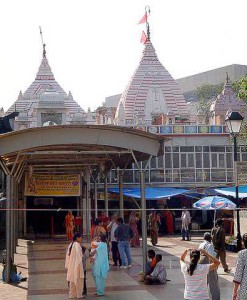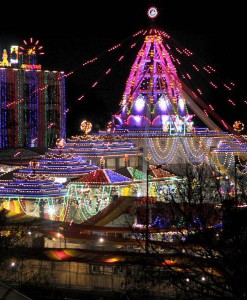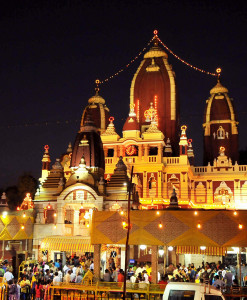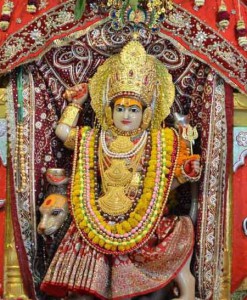No products in the cart.
Kalkaji Mandir, Delhi
Kalkaji Mandir is a popular and highly revered shrine of Delhi, the capital city of India. Kalkaji Mandir is situated in Kalkaji, a locality that has derived its name from the temple and is close to the famous Lotus Temple and ISKCON Temple. The temple is dedicated to Kalka Devi, one of the incarnations of Goddess Shakti or Durga.
The Kalkaji Mandir is also called ‘Jayanti Peetha’ or ‘Manokamna Siddha Peetha’ which literally means that all the desires of the devotees are fulfilled here by the Deity Goddess Kalika who has taken this temple as her abode. The general belief is that the image of the Goddess Kalka here is a self-manifested one, and that the shrine dates back to Satya Yuga when the Goddess Kalika had incarnated and killed the demon Raktabija along with other giant demons.
The temple is situated on the Suryakoota Parvata (ie. Suryakoota Mount) of Aravali Mountain Ranges. That is why we call Maa Kalka Devi (Goddess Kalika) as ‘Suryakoota Niwasini’, that is one who dwells at Suryakoota.
A 12-sided structure, Kalkaji Mandir has been constructed completely out of marble and black pumice stones. The black color is the sign to denote the goddess Kali, so the temple construction is made of with black stone.
The Kalka Devi temple complex is constructed of brick masonry finished with plaster (now with marbles) and is surrounded by a pyramidal tower. The Central Chamber which is 12 sided in plan diam. (24′ I.M.) with a doorway in each side is paved with marble and is surrounded by a verandah 8’9″ wide and containing 36 arched openings (shown as the exterior doorways in the Parikrama). This verandah encloses the Central Chamber from all sides. In the middle of the arcade right next to the eastern door is the eastern doorway there are two tigers fashioned in red sandstone sitting on a marble pedestal with inscriptions in Urdu. Between the two tigers there is an image of Kalkidevi with her name inscribed in Hindi and a trident of stone standing before it.
Existent from past 3,000 years, Kalkaji mandir traces many legends regarding its origin. However, the oldest part of the shrine was built in 1764 A.D, as per the folklore. The temple Kalka Temple is said to have been constructed by the Maratha Rulers in the late 18th century. Kalkaji Mandir is believed to have been survived from the times of Mahabharata.
As per the folklore, the Pandavas and Kauravas had worshipped Kalka Devi during the reign of Yudhisthir. In the words of Laura Sykes, “Marathas plundered the fair at Kalka Devi, near Okhla” at some stage in the battle of 1738 with the Mughals at Talkatora. In 1816 A.D. , Raja Kedarnath (Peshkar of Emperor Akbar II) made some changes and additions to the original structure of Kalkaji Temple, and for the last 50 years a considerable number of dharamshalas have been erected in the vicinity by the Hindu bankers and merchants of Delhi
It is also believed that the Goddess Kalkaji, pleased with the prayers offered and rituals performed by the Gods on the advice of Lord Brahma, appeared on this mount, known as Surya Koota Parvata, and blessed them. Ever since, the Goddess took this holy place as her abode and has been fulfilling the wishes of her devotees.
Devotees attend the Kalkaji temple throughout the year, but on religious occasions, Kalka Devi temple is thronged by innumerable devotees that come to have a glimpse of the Goddess. It is regarded that Kalka Devi fulfills all the legible wishes of her true devotees. During the time of Navratris (Mar-Apr / Sep-Oct), thousands of devotees come for the ‘darshan’ of the deity. For the period of nine days, a huge fair is organized in the vicinity of the temple.
Special Rituals/ Prarthana performed in temple
There is a ritual to bath the idol of Kalka Devi two times with milk before Aarti (worship) everyday in morning and evening. This, in turn, is followed by hymn recitation. Offerings can be purchased just before the entrance of the temple.
The atmosphere around the temple is airy and bright with lights which stay during the whole night. Devotees also try to meditate there and a tantric aarti is held in the evening.
Temple Pooja Daily Schedule
Morning Prayers Timing : 06:00 am to 7:30 am (winter), 05:00 am to 6:30 am (summer)
Evening Prayer: 06:30 am to 8:00 pm (winter), 07:00 am to 8:30 pm (summer)
By Road
Delhi is well connected to all the major cities of India by a network of highways and roads. Best way to travel in Delhi.
By Air
Delhi’s Indira Gandhi International Airport is connected to all the important cities of the world with almost all the major international airlines operating out of here. Palam Domestic Airport connects Delhi to the major cities in India.
By Train
The Indian Railway with their modern and organized network connects Delhi to all major and minor destinations in India. Delhi Metro connects the whole of Delhi. Nizamuddin Railway Station is the nearest railway station and Nearest Metro Station is Kalkaji Metro Station.
Kalkaji Mandir, Delhi










